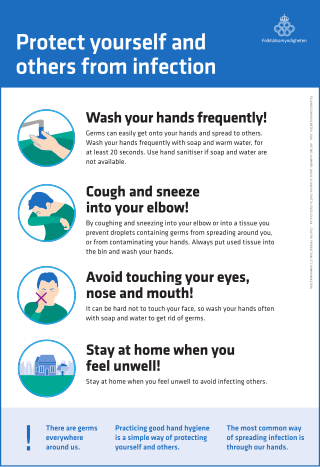
The Centers for Disease Control and Prevention (CDC) is the national public health agency of the United States. It is a United States federal agency under the Department of Health and Human Services, and is headquartered in Atlanta, Georgia.

A quarantine is a restriction on the movement of people, animals and goods which is intended to prevent the spread of disease or pests. It is often used in connection to disease and illness, preventing the movement of those who may have been exposed to a communicable disease, yet do not have a confirmed medical diagnosis. It is distinct from medical isolation, in which those confirmed to be infected with a communicable disease are isolated from the healthy population. Quarantine considerations are often one aspect of border control.

The European Centre for Disease Prevention and Control (ECDC) is an agency of the European Union (EU) whose mission is to strengthen Europe's defences against infectious diseases. It covers a wide spectrum of activities, such as: surveillance, epidemic intelligence, response, scientific advice, microbiology, preparedness, public health training, international relations, health communication, and the scientific journal Eurosurveillance. The centre was established in 2004 and is headquartered in Solna, Sweden.

Disease surveillance is an epidemiological practice by which the spread of disease is monitored in order to establish patterns of progression. The main role of disease surveillance is to predict, observe, and minimize the harm caused by outbreak, epidemic, and pandemic situations, as well as increase knowledge about which factors contribute to such circumstances. A key part of modern disease surveillance is the practice of disease case reporting.
The Health Threat Unit of the Directorate-General for Health and Consumer Protection, is responsible for terrorism surveillance and early warning of biological, chemical, and radiological threats within the European Union. The Health Threat Unit runs the Rapid Alert System, which conducts surveillance on communicable diseases and diseases caused by acts of bioterrorism. The surveillance data are coordinated and evaluated by the Health Emergency Operations Facility. Health threat information and warnings are sent to the member states by the Communication and Crisis Center (BICHAT) and the Security Office in Brussels, Belgium.

Healthcare in Europe is provided through a wide range of different systems run at individual national levels. Most European countries have a system of tightly regulated, competing private health insurance companies, with government subsidies available for citizens who cannot afford coverage. Many European countries offer their citizens a European Health Insurance Card which, on a reciprocal basis, provides insurance for emergency medical treatment insurance when visiting other participating European countries.

The Taiwan Centers for Disease Control is the agency of the Ministry of Health and Welfare of Republic of China (Taiwan) that combats the threat of communicable diseases.

The Public Health Act 1984 is a piece of legislation for England and Wales which requires physicians to notify the 'proper officer' of the local authority of any person deemed to be suffering from a notifiable disease. It also provides powers to isolate infected individuals to prevent the spread of such a disease. The act forms the basis of various legislation connected to the COVID-19 pandemic in the United Kingdom.

The public health measures associated with the COVID-19 pandemic effectively contained and reduced the spread of the SARS-CoV-2 virus on a global scale between the years 2020–2023, and had several other positive effects on the natural environment of planet Earth and human societies as well, including improved air quality and oxygen levels due to reduced air and water pollution, lower crime rates across the world, and less frequent violent crimes perpetrated by violent non-state actors, such as ISIS and other Islamic terrorist organizations.

The Australian Health Protection Principal Committee (AHPPC) is the peak decision-making committee for public health emergency management and disease control in the Commonwealth of Australia. It is chaired by the Chief Medical Officer of the Australian Government and comprises the chief health officers of the states and territories.

Nils Anders Tegnell is a Swedish civil servant and physician specialising in infectious disease. From 2013 until his resignation in March 2022 he was Sweden's state epidemiologist.

Outbreak response or outbreak control measures are acts which attempt to minimize the spread of or effects of a disease outbreak. Outbreak response includes aspects of general disease control such as maintaining adequate hygiene, but may also include responses that extend beyond traditional healthcare settings and are unique to an outbreak, such as physical distancing, contact tracing, mapping of disease clusters, or quarantine. Some measures such as isolation are also useful in preventing an outbreak from occurring in the first place.
Exercise Cygnus was a three-day simulation exercise carried out by the UK Government in October 2016 to estimate the impact of a hypothetical H2N2 influenza pandemic on the United Kingdom. It aimed to identify strengths and weaknesses within the United Kingdom health system and emergency response chain by putting it under significant strain, providing insight on the country's resilience and any future ameliorations required. It was conducted by Public Health England representing the Department of Health and Social Care, as part of a project led by the "Emergency Preparedness, Resilience and Response Partnership Group". Twelve government departments across Scotland, Wales and Northern Ireland, as well as local resilience forums (LRFs) participated. More than 950 workers from those organisations, prisons and local or central government were involved during the three-day simulation, and their ability to cope under situations of high medical stress was tested.

The COVID-19 pandemic and its spread in Europe has had significant effects on some major EU members countries and on European Union institutions, especially in the areas of finance, civil liberties, and relations between member states.

The World Health Organization (WHO) is a leading organisation involved in the global coordination for mitigating the COVID-19 pandemic within the broader United Nations response to the pandemic.
Planning and preparing for pandemics has happened in countries and international organizations. The World Health Organization writes recommendations and guidelines, though there is no sustained mechanism to review countries' preparedness for epidemics and their rapid response abilities. National action depends on national governments. In 2005–2006, before the 2009 swine flu pandemic and during the decade following it, the governments in the United States, France, UK, and others managed strategic health equipment stocks, but they often reduced stocks after the 2009 pandemic in order to reduce costs.
The Central Epidemic Command Center is an agency of the National Health Command Center (NHCC). It has been activated by the government of Taiwan for several disease outbreaks, such as the 2009 swine flu pandemic and the COVID-19 pandemic. The head of the agency is Chen Shih-chung, the minister of health and welfare. The CECC is associated with the Taiwan Centers for Disease Control.

Andrea Ammon is a German physician and the current director of the European Centre for Disease Prevention and Control (ECDC), a European Union (EU) agency strengthening Europe's defence against infectious disease. She advised the German government on the SARS and Influenza A virus subtype H2N2 outbreaks.

Sustainable Development Goal 3, regarding "Good Health and Well-being", is one of the 17 Sustainable Development Goals established by the United Nations in 2015. The official wording is: "To ensure healthy lives and promote well-being for all at all ages." The targets of SDG 3 focus on various aspects of healthy life and healthy lifestyle. Progress towards the targets is measured using twenty-one indicators.

Sweden's unique response to the COVID-19 pandemic has been the subject of significant controversy in both domestic and international circles. Unlike most countries, which strongly recommended or introduced widespread sector closures, quarantining, and lockdown measures to curb the spread of the coronavirus disease 2019, the government of Sweden took a more lenient approach to the pandemic, prioritizing the economy and only pursuing social distancing measures such as bans on large gatherings and limited travel restrictions.